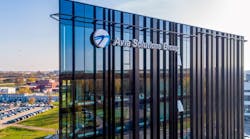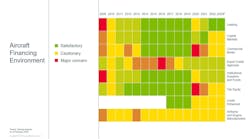Starting Oct. 1, 1992, the Federal Aviation Administration (FAA) will recognize technicians with a nationwide awards program. The program is titled Aviation Maintenance Technician Awards. An FAA advisory circular will be available in October and will explain the program in detail. But here is how it will work.
Overview
The Aviation Technician Awards Program is a two-part recognition program for both maintenance technicians and their employers. It was developed jointly by industry and the FAA.
Maintenance technicians will be recognized by the FAA for achieving higher levels of professionalism through training. Each award is based on the number of training hours acquired in industry courses, OJT training they have conducted and college-level management training completed
Employers will be recognized by the FAA based on the percentage of their employees who have earned FAA Aviation Maintenance Technician Awards.
Awards
There are a total of 10 awards. Five awards for aviation technicians and five awards for employers. Both sets of awards are divided into phases or groups that are identified as Bronze, Silver, Gold, Ruby and Diamond. The Bronze award is the easiest to achieve and the Diamond award the most difficult. Breaking the awards into phases will make it easier for the FAA to manage, and for industry to recognize what level of training has been earned.
Each eligible technician will be awarded Certificates of Training and an appropriate award tie tack/lapel pin. Eligible employers will receive an appropriate Certificate of Excellence.
A very important feature is included in this program; it’s called flexibility. A technician or the employer isn’t locked into a rigid system where they must pass through succeedingly difficult award phases to earn the highest award. Any eligible technician or employer who satisfies the requirements for the Diamond award within the upcoming calendar year will be issued that award.
The dated certificates of training are intended for display in your home or at work. However, once the pin is received, it should only be worn if you continue to remain current. Then it should be attached to the award certificate. Why? The lapel pin/tie tacks aren’t dated, and it just wouldn’t be right to wear an award based on the “current level” of training and professionalism, when you haven’t received additional training.
It should be stressed that you shouldn’t quit once you receive the Diamond award. Wearing a tie tack/lapel pin that’s current for a given year shows the rest of the industry that you are a professional and you intend to remain professional.
Calendar year
The awards program “calendar year” will run from Oct. 1 to Sept. 30 of each year. The reason behind this unconventional calendar year is because aligning the awards program with the government’s fiscal year makes the budgeting and management of the awards program less complicated.
Eligibility
The following aviation technicians are eligible:
- Certified airframe or powerplant mechanics
- Part 145 certified repairpersons
- Part 147 aviation maintenance technicians school instructors
- Part 147 school students who maintain an overall “C” average or better
- Uncertified maintenance technicians employed full time by Part 91, 121, 135 and 145 operators who actively maintain aircraft or components
- Employers who are in the full-time business of aviation maintenance and have at least five full-time aviation technicians on the payroll
Already I can hear the complaints from the hangar lunchroom. Why recognize uncertified people? And why give awards to employers?
First, it’s our hope that by recognizing the efforts of uncertified technicians and students who obtain additional training on their own or with their employers’ help, we as an industry will encourage these individuals to become certified.
Second, by recognizing the technician’s employer, we acknowledge that they’ve invested time, money and resources into training, and have suffered the loss of our productivity while we were in the classroom.
Applying for an award
Technician
At any time during the calendar year any eligible individual can apply either in person or by letter at the local FAA Flight Standards District Office (FSDO) for an award. Three items are required. First the individual must show proof that he or she is eligible. Acceptable proof is:
- An FAA mechanic or repairperson certificate
- Statement from an FAA-approved Part 147 school certifying that the student is maintaining at least a C average
- Statement from an FAA-approved Part 147 school certifying that the individual is an instructor at that school
- Statement from a Part 91, 121, 135 or Part 145 operator certifying that the individual is employed full time, by that operator, maintaining aircraft or related components
The second required item is a short letter to the FAA local FSDO describing the award requested. The letter should state where the training was received, who did the training, what training was received, how long the training was (in hours) and the date of the training. It must be signed and dated.
The third required item is some form of proof that the training was received. Copies of the certificates of training, attendance or graduation are acceptable as long as they collaborate the information supplied in the letter.
Employer
At any time during the calendar year an eligible employer can apply to the local FSDO for an award by letter. The employer’s letter should state the award requested and include:
- Employee is working full time on aircraft or component parts
- Total number of technicians working full time (at least five)
- Make copies of employee’s FAA certificate of training
Both the technician and employer should allow at least 30 days for the FAA FSDO to process the award request.
Technician award requirements:
Phase 1, Bronze: Four hours of FAA or industry training. (Note: Seminars of at least one hour can be added together to meet the four-hour requirement.)
Phase 2, Silver: Attend one FAA or industry maintenance seminar. Satisfactory completion of eight hours of FAA or industry training.
Phase 3, Gold: Attend one FAA or industry maintenance seminar. Satisfactory completion of a three-day FAA or industry training.
Phase 4, Ruby: Attend one FAA or industry maintenance seminar. Satisfactory completion of a five-day FAA or industry training or, teach a three-day (15-hour) maintenance course on aircraft systems.
Phase 5, Diamond: Attend one FAA or industry maintenance seminar. Satisfactory completion of a five-day FAA or industry training, teach a three-day (15-hour) maintenance course on aircraft systems, or satisfactorily complete a college-level course in either management or technical subjects.
Employer award requirements:
When a certain percentage of the total number of maintenance employees in an organization has received any one of the five FAA aviation technician awards within the “calendar year” that employer is eligible for one of the five “Certificates of Excellence.”
Certificate of Excellence percentage table:
Phase 1, Bronze: Requires 5 percent of the work force
Phase 2, Silver: Requires 10 percent of the work force
Phase 3, Gold: Requires 15 percent of the work force
Phase 4, Ruby: Requires 20 percent of the work force
Phase 5, Diamond: Requires 25 percent of the work force
We regret we cannot allow you to “grandfather” training you received prior to Oct. 1, 1992 and use that training toward an award. The awards program will only recognize training you received after Oct. 1, 1992.
This article first appeared in the September/October 1992 issue of Aircraft Technician. The awards were renamed the William (Bill) O'Brien Aviation Maintenance Technician Awards Program in June 2009 (AC 65-25E).

